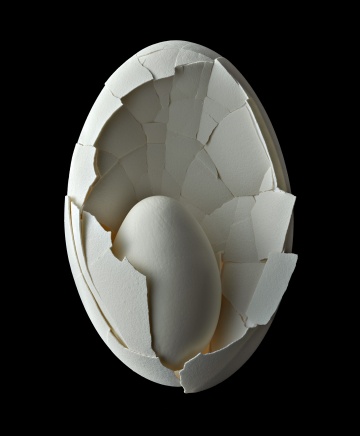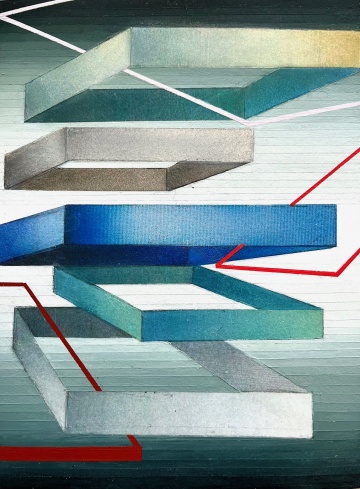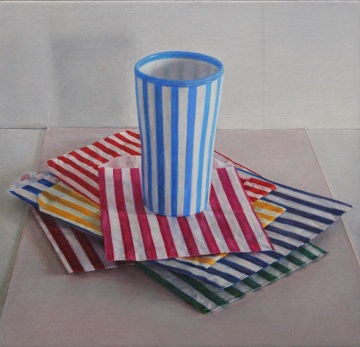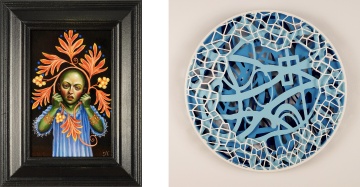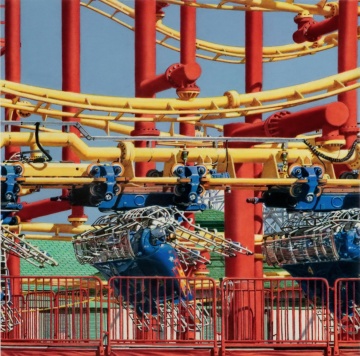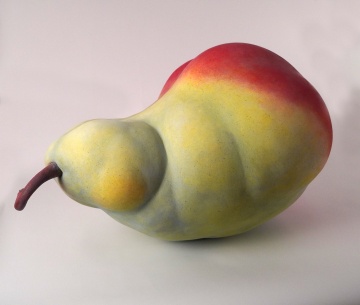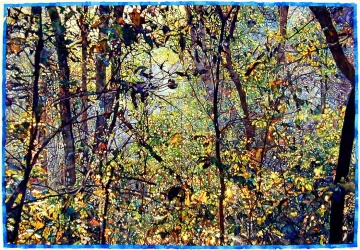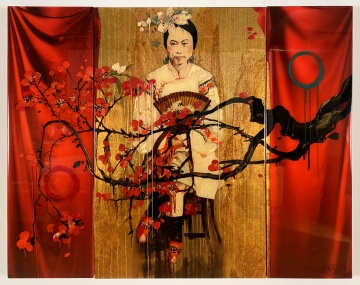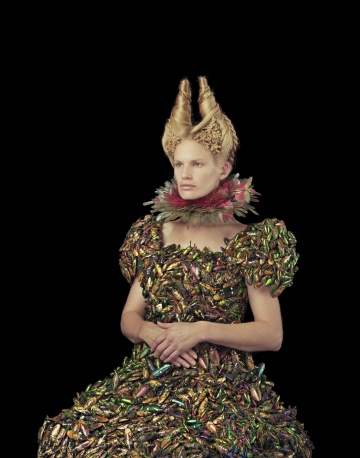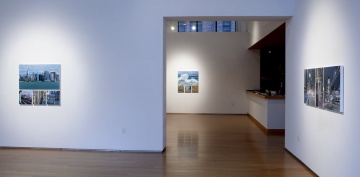Nancy Hoffman Gallery
520 West 27th Street
New York, NY 10001
212 966 6676
New York, NY 10001
212 966 6676
Nancy Hoffman Gallery opened in SoHo in 1972, among the first contemporary galleries downtown to show paintings, sculpture, drawings, photographs, video, and installations. In October 2008, the gallery moved to its new home at 520 West 27th Street in Chelsea--a light-filled space with majestically high ceilings and a sculpture garden.
Nancy Hoffman Gallery maintains commitment, consistency and loyalty to its artists over the years. Some of the artists have shown with the gallery since 1972, others have joined the gallery in recent years.
Nancy Hoffman Gallery’s active program consists of solo exhibitions in the main gallery, introductory shows in the project space, active participation in art fairs throughout the country, along with membership in the Art Dealers Association of America.
Artists Represented:
Nicolas Africano
Linda Mieko Allen
Ilan Averbuch
Joan Bankemper
David Bierk
Carolyn Brady
Colette Calascione
Mark Calderon
Timothy Cummings
Rupert Deese
Purdy Eaton
Don Eddy
Nathalia Edenmont
Nicole Phungrasamee Fein
Judy Fox
Viola Frey
Juan Gonzalez
Michael Gregory
Jody Guralnick
Gregory Halili
Jimi Kabela
Nancy Koenigsberg
Katerina Lanfranco
Hung Liu
Liséa Lyons
Lucy Mackenzie
Lynn McCarty
Carlton Nell
John Okulick
Frank Owen
Peter Plagens
Michele Pred
Richard Purdy
Joseph Raffael
Asya Reznikov
Bill Richards
Tiffany Shlain
Jesse Small
Inez Stover
Jim Sullivan
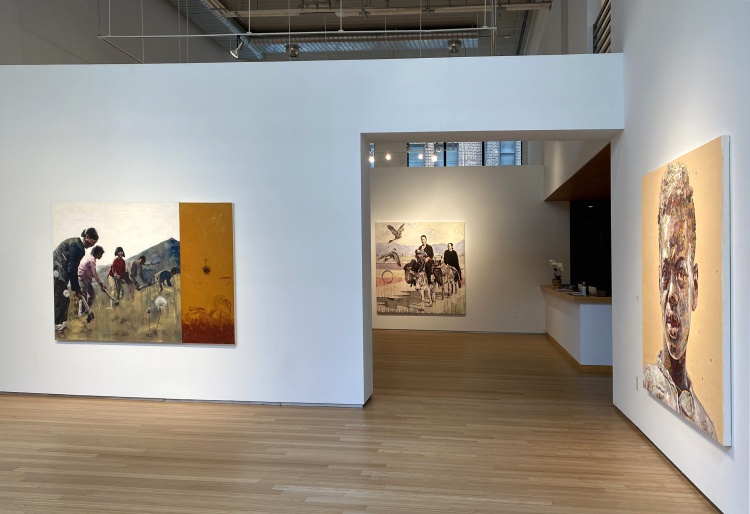

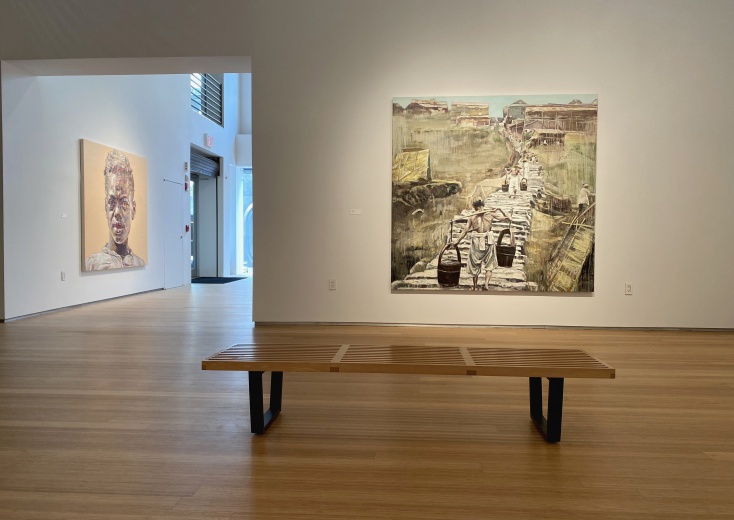
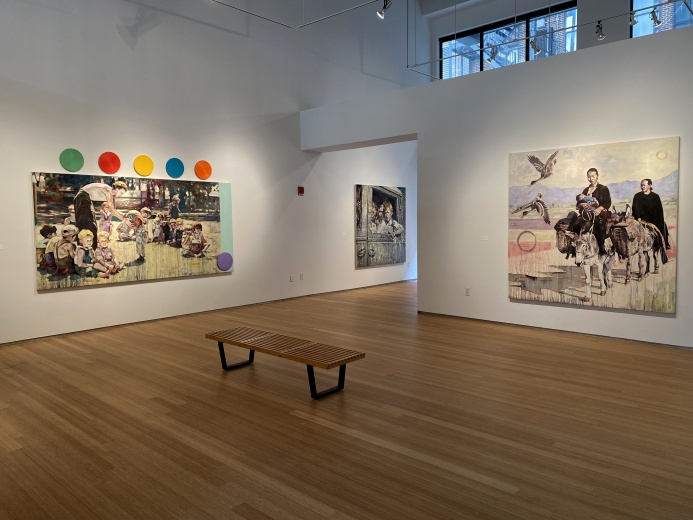
Hung Liu, Western Pass, 1990 - 2021
Hung Liu, Western Pass, 1990 - 2021
Hung Liu, Western Pass, 1990 - 2021
Hung Liu, Western Pass, 1990 - 2021
Nathalia Edenmont
Out of Body
January 30, 2025 - March 22, 2025
On January 30 th an exhibition of Nathalia Edenmont titled “Out of Body” opens at Nancy Hoffman Gallery. Included will be 15 photographs of eggs, and 7 sculptures, some of the same subject, as well as a few lilies in marble, created in Carrara. This is the first view of Edenmont’s major new body of work of the past several years and notably, her first foray into sculpture.
Edenmont is known for her large photographic portraits of women wearing dresses she composes of flowers or fruits and vegetables as well as for her collages of butterfly wings magnified into monumental photographic compositions. For this body of work, she was ready to take a leap into unknown territory, inspired by her personal connection to the beguiling goose egg.
Linda Mieko Allen
Atmospheria: Shape of Air
December 12, 2024 - January 25, 2025
NHG will show a new series of works by Linda Mieko Allen entitled Atmospheria: Shape of Air, works on paper of acrylic, ink transfer and graphite, each measuring 8 x 6 inches. The series continues the artist’s explorations of the atmosphere and the air around us as it changes and shifts.
It follows the thread of her investigation into atmospheric phenomena, spatial form, and manifestations of light, what she calls the “architecture of atmosphere.” The work alludes to the mysteries of the spaces in between. Two of her prior series were called Atmospherics and Thin Air, further underlining her commitment to the subject.
Jimi Kabela
Amalgamation
October 24, 2024 - December 7, 2024
From October 24 to December 7, 2024, Nancy Hoffman Gallery will present the first New York solo exhibition of work by artist Jimi Kabela, featuring richly painted abstract oil paintings from 2023 and 2024. Ranging in scale from tiny, at a scale of 5 x 7 inches, or large, at a scale of 5 x 8 feet, the paintings exude life force and energy in their lush, juicy use of oil, which the artist combines with bits of fabric from the Congo. The paintings integrate both sides of the artist’s life and heritage—born in the Congo and raised in the US—and offer a vista into both worlds.
Tiffany Shlain
You Are Here
September 5, 2024 - October 19, 2024
From September 5 - October 19, 2024, Nancy Hoffman Gallery will host its first solo exhibition of work by artist Tiffany Shlain, titled You Are Here. The exhibition will include a selection of Shlain’s tree-ring sculptures, supergraphics, light boxes, and photographs, among other works at the intersection of feminism, philosophy, technology, neuroscience, and nature.
Says Shlain, “In You Are Here, I look at what happens when we step back to view ourselves within the expansiveness of nature and time through the lens of feminism, neuroscience, ecology, and philosophy. I consider how this scale realignment can change our perspective, offer context, reveal absurdities, and evoke humility, insights, and awe.”
Inez Storer - Nancy Koenigsberg - Joan Bankemper/Sophie Bankemper Frances
THREE WOMEN’S VOICES
May 30, 2024 - July 19, 2024
Lucy Mackenzie
Still
March 21, 2024 - May 25, 2024
On March 21 an exhibition of new paintings and drawings by Lucy Mackenzie opens at Nancy Hoffman Gallery, the artist’s first show in eight years, including oil paintings of intimate scale and drawings. The exhibition continues through May 25. Her 2015 show, Quiet, set the stage for the new works, which follow in its footsteps. With continuing commitment, Lucy Mackenzie composes images that convey serenity and poetic observation.
In this exhibition of over 40 works the viewer stops to reflect not simply on the artist’s choice of subject or object, but also on the appreciation for items we rarely take time to examine, enjoy or embrace.
The paintings measure from 3x3 inches up to 4x7 inches. The artist works for several months on each piece, creating around four paintings a year, objects of contemplation and devotion, each a timeless world, each a touchstone to a larger story of life.
Nancy Koenigsberg & Jody Guralnick
LINE AND SHADOW/TELL ME A SECRET
February 1, 2024 - March 16, 2024
Nancy Hoffman Gallery will present an exhibition of sculptural works by artist Nancy Koenigsberg and paintings by artist Jody Guralnick from February 1 through March 16, 2024. This is Nancy Koenigsberg's first exhibition with the gallery. The exhibition will include approximately 25 of her works, made between 1998 and 2023, focusing on wire sculpture. Her wall pieces and installation works are woven, knotted, crocheted, or otherwise manipulated from various weights and colors of copper, steel, and aluminum wire. Woven or knotted grids are shaped and layered. Materials are shiny and dull, fragile, and industrial strength. The various combinations and contrasts challenge and engage the viewer both visually and conceptually.
The exhibition of work by Jody Guralnick will include approximately 15 works, made between 2022 and the present. Works in the exhibition range from 12 x12 inches up to 60 x 144 inches. The paintings depict the winding patterns that lichen forms on rocks, as well as the branching hyphal patterns of fungal growth. The lichen, painted in acrylic in rich and alluring impasto, stands in bas-relief against an oil background evocative of nature’s palette.
Timothy Cummings & Jesse Small
Blue Boy/Distant Signals
December 14, 2023 - January 27, 2024
Timothy Cummings - BLUE BOY
While most of Cummings’s paintings are dream-like fantasies filled with myriad detail and discovery, each has a figure or figures. Much of Cummings’s work addresses the issue of youthful turmoil, of that awkward moment between childhood and adulthood, of identity, of gender. The artist often paints figures as a child might conjure them in his/her mind, giving a dreamlike, fantasy quality to a grown-up persona.
Jesse Small - DISTANT SIGNALS
The exhibition will feature Small’s newest series of work, featuring layers of pierced metal screens which create a three-dimensional relief on the wall. The layers are well spaced to allow light to diffuse through the sculpture and generate shadows below.
The artist writes of these new wall sculptures, “The layered patterns come from drawings I have been working on for the past 15 years, right up until today.
Don Eddy
New Work
October 26, 2023 - December 9, 2023
On October 26, an exhibition of new work by Don Eddy opens at Nancy Hoffman Gallery, and continues through December 9. Eddy is one of the few early Photorealist artists who has taken his vision into new terrain, and has expanded his unique painting process. Please join us for the opening reception Thursday, October 26 from 6 to 8pm.
In this exhibition, more than 20 new paintings from 2020-2023 are presented, ranging in scale from 59 x 44 inches to 9 x 12 inches. This new body of work was made during and directly after COVID-19 lockdown in New York City. Eddy explains, “The streets were empty, there was nobody out, and in an interesting way, this became my city in a way it never had been before. I would take epic walks, and subway rides—I would just get off and start walking—and it had a profound effect on me. When the first wave of COVID started lifting, just as spring was arriving, it felt like a rebirth for myself and the city.”
While the manifest content of Eddy’s work is the cityscape and nature, his overriding subject is light: light as it sparkles on the bridges of Manhattan, and glistens on the rushing rivers of Oregon. In Water and Light, 2023, the subject is clear, nature is the vehicle for the expression of both the magical and the sacred.
Judy Fox
Harvest
September 7, 2023 - October 21, 2023
On September 7, Nancy Hoffman Gallery opens Harvest, an exhibition some 50 newly created terra-cotta sculptures by Judy Fox, made in her studio in Rhinebeck, New York. The sculptures depict fruits and vegetables, dynamic in form and palette, a veritable organic feast. Ranging in size from 30 inches to 3 inches, the works are painted in exquisite detail with casein paint.
Harvest continues a migration from the painted figures that launched Fox’s sculpture practice in the 1980s. The installation presents a new set of biomorphic sculptures, now no longer orbiting a human character. Instead, a deep understanding of the body animates plant-based subjects.
Linda Mieko Allen, Joan Bankemper, Rupert Deese, Don Eddy, Nathalia Edenmont, Nicole Phungrasamee Fein, Hung Liu, Carlton Nell, Katerina Lanfranco, Jesse Small.
CLIMATE NATURE NATURE CLIMATE
May 11, 2023 - August 31, 2023
CLIMATE NATURE-NATURE CLIMATE is based on the impact of climate change on the earth. Several of the artists created works for the exhibition and most of the artists have contributed statements on the subject of climate change, and how it has impacted their thinking and their work. The exhibition opens on May 11 and continues through the summer. In addition to the statements, the gallery created a video with important quotes on the subject. Additional information and images are available now.
Hung Liu
Two Continents: Themes and Variations
March 9, 2023 - May 6, 2023
In Themes and Variations, we honor the vision of the artist in a medium that was truly her own, to which she applied the same energy and principles she applied to her oil paintings. Themes and Variations is a celebration of Hung Liu and her abiding commitment to humanity, seen most profoundly in her portraits both from Chinese historical images and Dorothea Lange photographs. While many of her subjects were refugees, or field workers, Liu depicts them with honor and dignity.
Abstractions
January 12, 2023 - March 4, 2023
On January 12, 2023 Nancy Hoffman Gallery opens Abstractions, a show of paintings, sculpture, and watercolors by Linda Mieko Allen, Rupert Deese, Nicole Phungrasamee Fein, Lynn McCarty, Frank Owen, Peter Plagens, Rick Purdy and Jesse Small. In conjunction with the exhibition the gallery asked each artist to write a statement about Abstraction and its importance to them. These statements speak to the impetus for the show and the abiding life and vitality of abstraction in the painting of today. Below are just a few excerpts from some of the artists as an introduction to the work and the show. Each of the artists will be represented by three or more works to provide the viewer with a window into the range of the seven artist’s visions.
While there are many definitions of abstraction, a simple one says it all: Abstract art deals with ideas and frees the artist from issues of representation. Abstract art is about shape, form, color and space, not about depicting the real world. Many say abstract art is a 20th century invention, a modern movement. After World War II, abstract art became a dominant form of art in the United States, followed by Abstract Expressionism, an American phenomenon. Abstraction has been and continues to be part of the American art vernacular since it blossomed in the early 20th century.
Viola Frey
Faces, Masks, and Figurines
November 10, 2022 - December 31, 2022
Nancy Hoffman Gallery is honored to host Viola Frey’s fifth posthumous show: Faces, Masks, and Figurines. Though known for her monumental ceramic figures of every man and every woman, Frey simultaneously worked on sculptures in a variety of scales, as well as drawings and paintings that feature the figure surrounded by a panoply of her figurines. This presentation offers a more intimate view of the artist’s work: a look into the personal and autobiographical nature of her drawings and paintings, as well as the allure of her tondos and smaller sculptures. Viola Frey: Faces, Masks, and Figurines will be on view from November 10 through December 31, 2022.
Michele Pred
Equality of Rights
September 8, 2022 - November 5, 2022
“Equality of rights under the law shall not be denied or abridged by the United States or by any State on account of sex.” – (Not-yet-ratified) 28th Amendment
Michele Pred’s solo show at Nancy Hoffman is a continuation of her work on Equal Rights for Women with a focus on Pay Equity and Abortion Rights. These recent works shine a light on historic and present-day inequities while demanding action now.
Frank Owen
Retrospection
May 5, 2022 - September 2, 2022
Retrospection is an act of looking back. It is a mental process of remembering done in the hope that those recalled facts and experiences might enrich the present and the future. As a painter who has long relied on creating and using multiple image events to be collaged into my paintings, I am always looking back at my form inventory. As someone in the eighth decade of life, I often recall memories, excitements and, occasionally, instances of "Whew." This exhibition is the 12th with my dealer and friend of 51 years, Nancy Hoffman. It is a two-part combination of work. The first is a group of paintings that measure 50 x 40 inches from 2017 to present. I undertook to make smaller pieces as a necessary response to shoulder surgery gone wrong. It became apparent that continuing at this smaller scale was the best path. Plus, it proposed an exploratory quest of my images, means of making and imagination. It shall continue.
Frank Owen
Michael Gregory
If You Came This Way
March 17, 2022 - April 30, 2022
In the new work the artist has incorporated his experience of living on the East Coast in the Hudson River Valley, after spending most of his life in California. Gregory takes advantage of the four seasons, embracing the different topography and light; exploring the palette of snow-filled fields. Barns of rainbow hues appear inspired by the Pennsylvania Dutch tradition of using pink, blue, green, yellow to bedeck structures in that part of the world. Most of the paintings embrace color in a poetic, subtle and rich fashion.
Joseph Raffael
Regeneration
January 27, 2022 - March 12, 2022
For his newest series, the artist combines his love of pure nature with that of animals, what he calls “spirit beings.” Seeing an image of a bee in flight about to land on a blue flower piqued his interest to begin the series. The suggestion of flight, a quiver of movement, almost impossible to capture, became a touchstone to renewed energy in the work. Regeneration, the title for Raffael’s show tells the tale. These works have a shimmering intensity, a life force urgency that is palpable.
Joan Bankemper
Flora and Fauna in Flux
December 9, 2021 - January 22, 2022
The artist began this series at the start of the pandemic with ink drawings, on pages from her daily journal (written in isolation) that she calls her “Pod Series.” The drawings began at an intimate scale of 22 x 17 inches and blossomed into a larger, bolder format approximately 44 x 32 inches. Pod is a word with many meanings: it is an elongated seed encased in an outer shell; it is a protective container; or a small, designated group of people. As the Covid crisis began we were all advised to isolate at home, or to stay within a limited “pod” of people we could trust to be safe. Thus, the “Pod “ is a vital element of Flora and Fauna in Flux. The flower is a recurring image in this series, as is the maze. The flower is about rebirth, nature, and the artist’s flourishing garden on the farm where she lives. The maze represents the days and months of the pandemic, finding a way out.
Hung Liu
Western Pass, 1990 - 2021
September 9, 2021 - December 4, 2021
Throughout her career, Liu has drawn her subjects from the lenses of historical photography, including the staged Orientalism of the 19th century (young prostitutes and dynastic courtesans) and, primarily, the social realism of the 20th (refugees, orphans, and peasants). While the majority of her works constitute an extended homage to the common people of her homeland, her paintings of the last six years have focused almost exclusively on the individuals and families ennobled in Dorothea Lange’s photographs.
Nicole Phungrasamee Fein
Joy Fields
May 13, 2021 - July 3, 2021
Watercolor has long been the medium of choice for Nicole Phungrasamee Fein whose first solo exhibition at Nancy Hoffman Gallery opens on May 13 and continues through July 3, 2021. For two decades, she has made drawings sequentially, always working on paper. With a meticulous hand and singular focus, Fein challenges the conventional use of watercolor and defies the limitations one associates with the medium. Fein builds fields of complex, luminous color and creates patterns using a technique she calls “speckle,” a highly controlled way of manipulating veils of color. The artist has said: “Slowing down is fundamental to what I do. I approach each work in a methodical, iterative manner.” Thus, the works have a meditative, ethereal quality and a quiet strength as they address the square format of the paper. The central field of paint might be a circle, a square, or a whimsical geometric configuration.
Over the years Fein has distilled her imagery following her quiet yet profound voice. Each work is an object of contemplation, coming to life as the artist adds one layer after another until the image resolves. It may be an eclipsing color wheel or a circle emerging as a mirage-like planet born from a drop of water. It may be a pinwheel-like form of varied colors or a square created with thin speckled washes which live and breathe at the edge of the image as secrets that lie beneath what appears to be green, russet or blue. The droplets intermingle on the paper, creating rich fields and dense composites of color.
Nathalia Edenmont
Rebirth
January 5, 2021 - May 8, 2021
Swedish artist Nathalia Edenmont’s exhibition, “Rebirth,” opens on May 7 and continues through June 20. Long fascinated by butterflies, their sheer natural beauty, and their symbolism, Edenmont centers her show around these elusive creatures, creating the largest collages on which she has ever worked, as well as creating garments of iridescent beetles in which she dresses her “sitters” or models.
Known for her images of women wearing dresses composed of fruits and flowers, Edenmont takes, what for her, is the next step, toward dresses composed of luminous creatures –no longer alive—golden, green, iridescent pink, blue, shiny, shimmery beetles. A beautiful blonde woman sits placidly as a dress is composed around her, a process that takes from 14-22 hours of work for a team of ten people. Edenmont is the director, the creator, the orchestrator of the photo shoot. Everything in the photo is real. It is “shot” with 8 x 10 film. There is no photoshop, no digital manipulation, no correction of any kind. The artist has to capture what she wants when she clicks the camera or many sheets of 8 x 10 film, hours of work and cost are gone.
The artist has attended butterfly fairs all over the world for years to accumulate a sufficient supply of butterflies and beetles to compose her palette. In the new works, the beetles represent transition. A young, beautiful body is hidden and transformed by the beetles, taking the form of a pupa; life transforming from one stage to another. In these portraits, Edenmont continues her exploration of fundamental themes such as birth, death, womanhood, sex, beauty and decay. The works present us with an implied tension between painting and photography, abstraction and figuration, and most importantly attraction and repulsion. Like “beauty and the beast” we are drawn in by the beauty and become squeamish when we know the dress is comprised of hundreds of beetles.
In addition to the four new portraits, Edenmont shows several new butterfly collages, the fruits of over 500 hours of work each. The collages become the “maquettes” for her monumental scale photographs. The collages and photographs are composed of hundreds of butterfly wings, all natural and not colorized. The large-scale photographs, brilliant in color, are what the artist considers her abstract paintings.
Joan Bankemper, Don Eddy, Katerina Lanfranco, Hung Liu, Lynn McCarty, Joseph Raffael, Jody Uttal
From Prayers to Urns
November 5, 2020 - January 2, 2021
For the first time in our history, we have lived through a Spring and Summer of lockdowns, mask wearing and social distancing due to the coronavirus. Our lives have changed, our patterns of social engagement have changed, and for some artists, the art that has been created during this time has changed. Impacted by the Pandemic, each of the artists in the exhibition has addressed the health crisis differently. Early on in the Pandemic, Hung Liu began a series of Prayer paintings inspired by the cave paintings at Dunhuang in China, which she visited when an art student there 50 years ago. Every 12 years during the year of the rat, the identifying year she was born, Hung Liu paints two paintings 64 x 100 inches each. This year, emblematic of the Pandemic, she painted herself in masks, one the color of linen juxtaposed with a dandelion that has one remaining seed; in the other she wears a mask made from a scarf with the American flag motif juxtaposed with a Chinese character comprised of five strokes. This character is typically used to count time. She paints the same character over and over, counting time. There is no beginning, no end to this time.
Katerina Lanfranco’s high-key color paintings, with seeds in both nature and abstraction, incorporate bits of torn fabric, yarn and synthetic flowers, which she overlays with glitter, sand, and paint. As she says, “The many layers of paint applications and diverse techniques speak to the cacophony of modern life.” Her paintings are simultaneously an abstraction of the virus’s spherical form and a celebration of life in its transformation thereof.
Don Eddy’s Silent Spring diptych was inspired by a walk down Broadway on April 5, 2020. Everything was closed, there were no people in the street. When the artist reached the end of the island he came upon a flowering magnolia tree, and an empty shuttered ferry terminal, the juxtaposition a poetic comment on the Pandemic, the lockdown, the many deaths throughout the country and especially in New York at that time. The magnolia tree appeared like a symbol of hope. Spring was presenting itself in spite of the virus.
Joan Bankemper began a series of urns shortly after the Pandemic began. Having made commemorative urns during the AIDS crisis, the artist seemed to have no choice but to continue that impulse and create what she calls funereal urns, hand coiled pots filled with forget-me-knots and bees. While the urns are not dedicated to any specific person, they are imbued with both the sadness and death of the times as well as symbols of life as manifest in the proliferation of bees. The flowers the artist hand-builds to bedeck the urns speak for themselves: forget-me-knot, or “forget-me not” when I am gone.
Joseph Raffael’s Elegy series is a tone poem to a loved one after death. The artist focuses in on a single flower, a central subject and surrounds each bloom with one color. Magnified in scale, with each petal curling toward the viewer, Raffael zooms in on the flower, which is solid and ephemeral simultaneously, an object of meditation.
Painted during the months of the Pandemic, Lynn McCarty’s oil paintings on aluminum became about COVID, as she says “through slow layers of time.” The artist writes about the works: “One is open with two separated shapes - yet singular, isolated but warm and together; one is dreamy in an aquatic way, restless and drifting. Inside and outside, above and below. Serene yet ominous. The last pulls together a sort of human depth and darkness into a colorful possible light. Highlighted embers and deep etched random grooves occupy a space filled with history.”
For Jody Uttal the works are a direct reflection of the way she was feeling. When the virus first hit, she felt unsafe, and started making tight watercolors with little breathing room or space. As time passed and as she stayed at home, her fear diminished as she accepted the new reality of sheltering. The artist writes about this work: “The watercolors started opening up. There was space in the patterns. Light could come in. They were almost like scrims that I could look through.”
The works in this exhibition are a testimony to the enduring spirit of art, springing from this time of uncertainty, isolation, and death.
Don Eddy
Don Eddy 2020
March 19, 2020 - June 30, 2020
On March 19 an exhibition of new work by Don Eddy opens at Nancy Hoffman Gallery and continues through April 30. Eddy is one of the few early Photorealist painters who has taken his vision into new terrain, and has expanded his unique painting process. In the ‘70s Eddy painted the California urban landscape, focusing on cars, reflections on cars, bumpers, headlights. The subject came naturally to the son of a car body and fender shop father. The artist moved quickly from cars to storefronts to shelves filled with glassware and toys.
Eddy’s work of the past four years takes him deeper into the exploration of nature, perception and life’s mysteries. His multi-panel paintings take on a quiet spiritual aura in their contemplative examination of earth’s riches; as well as the magic of the night in the cities he visits. The artist’s subject is as much light as is the manifest content; he paints, as catalogue author David C. Graves writes, ”images that he has meticulously crafted out of the substance of his life’s experiences. He manipulates those images, as if distilling them so as to capture naught but their very essence. He universalizes those substances, so as to make them rich enough for poetry and accessible enough for us to engage.” Some of his new paintings are triptychs with three sections, others are polyptychs with four or five wooden panels. For the past several years Eddy has returned to the urban landscape, this time New York; as well as his experiences in nature, celebrating light and season in the energy of the ocean, a mountain at sunset, a lotus in full bloom.
Painted in 20-30 layers of transparent acrylic over an under painting of three colors (the first being circles about a 20th of an inch in diameter of phthalocyanine green, the second being burnt sienna and the third dioxazine purple). With these three colors he separates warm from cool colors, and then begins to add many layers of transparent color to achieve the final palette of each work.
Hung Liu
This Land
October 24, 2019 - December 7, 2019
Clay
June 19, 2019 - September 3, 2019
Michael Gregory
November's Guest
April 24, 2019 - June 8, 2019
Judy Fox
Garden
March 14, 2019 - April 20, 2019
The Figure
January 26, 2019 - March 2, 2019
Linda Mieko Allen
Supernatura
November 29, 2018 - January 22, 2019
Michele Pred
Vote Feminist
October 18, 2018 - November 24, 2018
Sculptors and their Drawings
September 6, 2018 - October 13, 2018
Flowering
June 21, 2018 - September 1, 2018
Rupert Deese
May 3, 2018 - June 16, 2018
Jesse Small
Empty Objects
March 15, 2018 - April 14, 2018
Joan Bankemper
March 15, 2018 - April 14, 2018

 Back to all Member Galleries
Back to all Member Galleries

